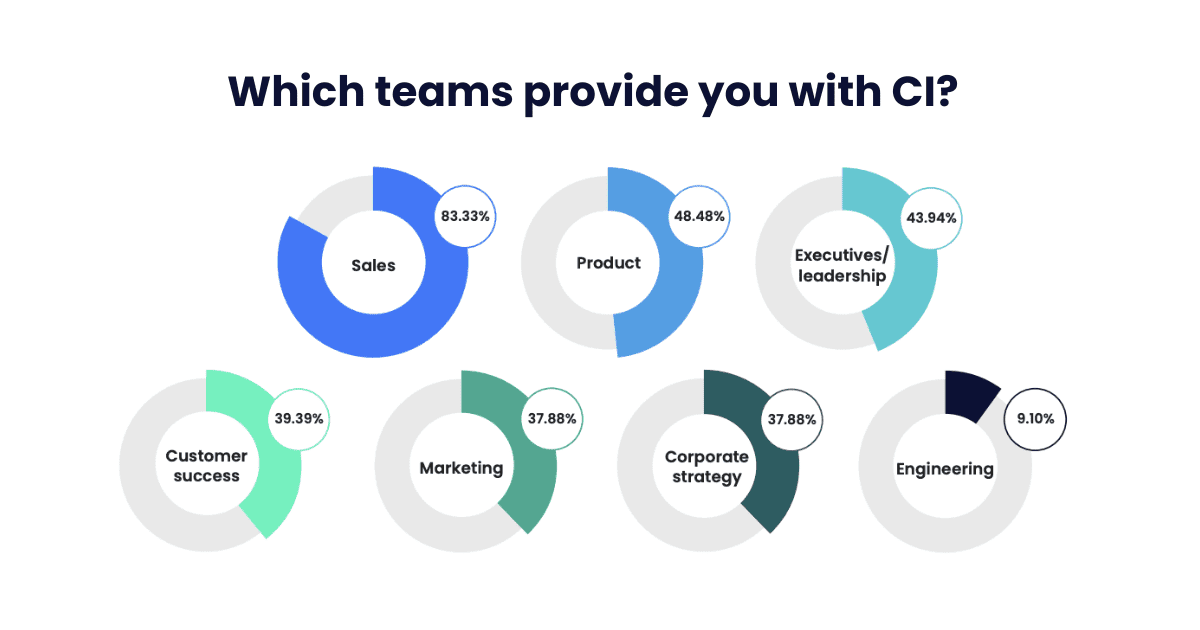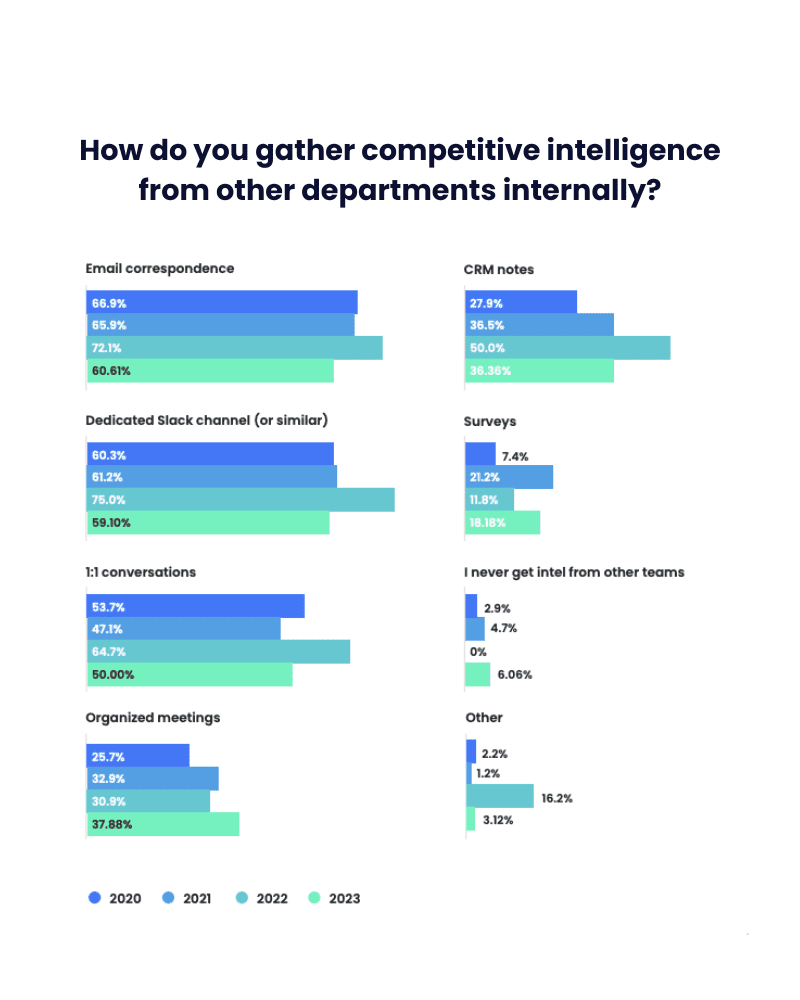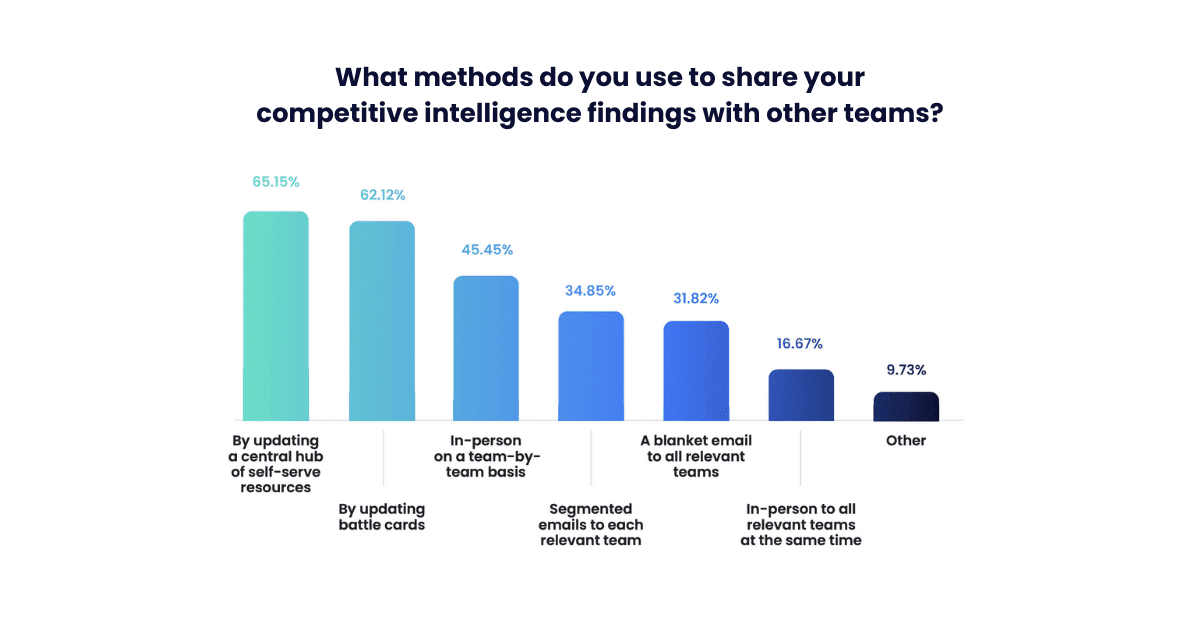As a competitive intelligence (CI) practitioner, you’ve likely got the scoop on your rivals, but have you ever wondered what your peers are up to? After all, they certainly have lessons to share that could help you raise your CI game even higher.
Luckily for you, every year we survey the crème de la crème of competitive intel to get a sneak peek into their practices (oh, how the tables have turned!).
So, strap in and get ready to learn:
- Which teams CI practitioners work with most closely to get the job done.
- How CI pros gather competitive intelligence from other departments (and how they deliver it to teams.)
- How CI pros get hold of hard-to-access pricing intel.
Let’s get into it.
Cross-functional collaboration in competitive intelligence
Collaboration is at the heart of competitive intelligence (CI). Effective CI programs crowdsource the intelligence-gathering process, leveraging the many eyes and ears throughout the business to capture as much relevant intel as possible.
Sounds great in theory, but how does that pan out in practice?
Well, every year for the Competitive Intelligence Trends Report , we ask product marketers and CI professionals to rate other teams' openness and proactivity when it comes to sharing competitive intelligence. In our most recent survey results, the modal value was a perfect 10/10 with 16.67% of respondents awarding internal teams this score. Great news, right?
Not so fast!
The average score hit a four-year low last year at just 6.56, down from 6.9 in 2022 and 7.4 in both 2021 and 2020. But is this declining score a cause for concern? We asked Fiona Finn , Director of Product Marketing at Jane.app, what she thought:
“If I see a declining score in anything, I’ll turn that into a question. Do folks know how to do this? Do they know where to share this?
“If the answer is ‘no’, there’s something very actionable. You can build those programs, open a Slack channel, set up check-ins…
“If the answer is ‘yes’, that could be indicative of two things. Either your own CI program is too siloed, so that’s a negative. Or, it could be a good thing in that you’ve now taught your stakeholders how to fish, how to do competitive research, and they’re feeling confident to run things themselves.”

Cross-functional CI superstars
So, when it comes to gathering and sharing CI, the more the merrier (though not all teams are as proactive as they could be).
But which functions are actually coming up with the goods? We asked our CI and PMM pros which teams provide them with competitive intel most regularly.
Perhaps unsurprisingly, given their constant contact with customers and their vested interest in getting all the competitive intel they can lay their hands on, sales came in top, supplying 83.33% of our survey respondents with intel.
Meanwhile, product and leadership came in second and third place respectively, serving the tea to 48.48% and 43.94% of our survey takers.

It’s fair to say that sales teams are on it as far as gathering CI is concerned, while other departments have some serious catching up to do. Want to help them get involved? Check out these top tips from Patrick Wall , Director of Product Marketing and Competitive Intelligence at Imperva.
How CI pros gather competitive intelligence from other departments…
The best CI pros are proactive. They don’t wait for other teams to give them intel – they provide those teams with processes and places to log and share key info when they come across it.
So, how are today’s CI whizzes collecting competitive intelligence from other departments?
According to our survey results, email correspondence continues to lead the way, – albeit by a narrower margin than in previous years – with 60.61% of CI pros relying on this medium to gather intel internally.
Hot on email’s heels are dedicated Slack channels (or similar solutions), which are used by 59.10% of our survey takers. Meanwhile, good old-fashioned one-on-one chats are the third most popular way of gleaning intel from other teams, with 50% of survey respondents sitting down for regular chinwags with their cross-functional peers.

How CI pros deliver intel to teams
When it comes to collecting intelligence internally, email reigns supreme – but how do CI professionals prefer to spread the word about their company’s competitors?
Our survey found that the two most selected most common methods are updating a central hub of self-serve resources (65.15%), and updating battlecards (62.12%). A fair chunk of respondents (45.45%) also reported updating other teams via in-person briefings.

Other (less popular) methods included:
- Dedicated Slack channel
- Microsoft Teams channel
- Written reports
- Internal blog articles
- Slack and Loom updates
Your best bet might well be to leverage a combination of these approaches – that way, you increase the chances that everyone knows what’s up with your rivals.
Here’s how Fiona Finn does it at Jane.app:
“There’s the proactive and reactive side. We’ll do once-a-quarter proactive outreach to our Customer Success folks, just to make sure everyone’s in the know there.
“The reactive sourcing would be through a Slack channel, and then ensuring that product marketing updates the sources of truth, and that the whole organization is very aware of what those sources of truth are.
“We’ve recently started doing a CI newsletter, which is very simple, very high level. We’re not trying to overwhelm, but we include any updated competitive toolkits, the top three need-to-know headlines of what’s going on in the CI world, and then an ‘in case you missed it’ from the last one.”
So, why not take a leaf from her book and start broadening your approach to sharing intel today?
The challenges faced by competitive intelligence practitioners today
Whether you’re a PMM struggling to perform CI alongside a list of other responsibilities, or a dedicated CI pro battling to win your stakeholders’ buy-in, CI has its challenges.
We wanted to get a sense of the challenges competitive intelligence practitioners have been facing over the last 12 months, so we asked!
Four clear themes emerged from their responses:
- A lack of time (or other resources).
- Getting access to non-public information.
- Collaborating effectively with internal customers and competitive-facing teams.
- Verifying the accuracy of the intel you find.
Here are just a few of our respondents’ comments:
Lack of time
- “It takes a lot of time to be thorough.”
- “Since we don't use any CI tools, I have to comb through articles and the internet and just don't have the bandwidth to do this with any consistency. Plus, I believe CI tools are able to do deeper dives and uncover more information than I am able to do manually.”
- “In the B2B2C world, info like pricing and product specs are hard to come by. It takes a lot of manual resources to locate information.”
Accessing difficult-to-obtain information
- “Getting information on pricing and packaging.”
- “Lack of access to information on privately held companies.”
- “Capturing the intel we can't see – sales team conversations, prospect feedback or insights, etc.”
Collaborating with internal customers
- “Ensuring our customers (our internal customers of our competitive intel, e.g. sales) understand the value of their contribution (i.e. the depth of detail they provide, sources, etc.)”
- “Getting customer-facing teams to read our materials and use our materials.”
- “Translating findings into impacts.”
Verifying intel’s accuracy
- “Validating the authenticity of the information, especially when it's not available on the competitor’s website.”
- “Cross-checking information to make sure it’s accurate. Getting it in real time, not a month later.”
- “Determining whether the source of the intelligence is credible.”
Yikes! 🤯
Before you start to despair at the scale of the challenges ahead of you, let’s explore some solutions to the challenge of laying your hands on that tricky-to-gather pricing intel.
And why not check out the Competitive Intelligence Playbook for more tried-and-tested tips on running a stellar CI program?
How CI pros get hold of hard-to-access pricing intel
Pricing intelligence is notoriously difficult to gather. In case you were wondering how to get your mitts on it without breaking the law (please don’t do that!), we asked our survey respondents how they go about finding a competitor’s pricing information when it’s not listed on their website.
“We don’t,” was the despondent answer from more than a few of our respondents. As one person said,
“In B2B SaaS, this is very challenging. We have some intel from employees that came from a competitor, but honestly, we have very little information around pricing.”
However, for those with the time and the tenacity, the best bets could include:
- Asking prospects: “Sales reps share what they are hearing and then benchmark for trends.”
- Asking your own customers: “[We] ask customers/buyers through surveys or interviews, [then] analyze their discounting practices relative to our price through CRM data.”
- Asking your competitors’ customers: “Existing and former customers and prospects, former employees, industry analysts.”
- Mystery shopping: “Use their product or request a demo.”
That’s a wrap!
Hopefully, this whistle-stop tour of the competitive intelligence landscape has given you some ideas to integrate into your own CI practices. If you’re ready to dive even deeper, why not check out the Competitive Intelligence Trends Report in its full glory?

To make your voice heard in the next report (shameless request alert!), just click here!




.png?v=40ae029d56)